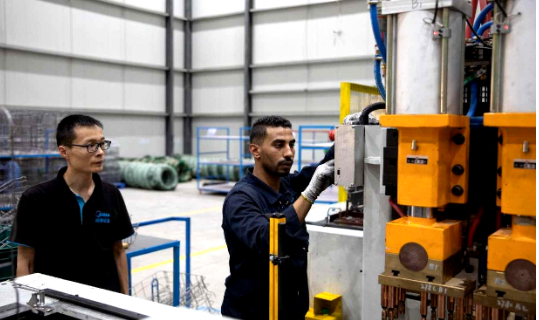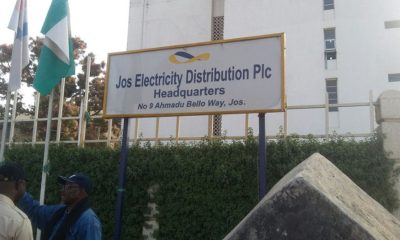Foreign
China-Egypt cooperation zone contributes to Egypt’s industrial modernization

By Zhang Zhiwen, Zhang Mengxu, Shen Xiaoxiao, People’s Daily
The China-Egypt TEDA Suez Economic and Trade Cooperation Zone(SETC-Zone), which sits on the shores of the Red Sea and south of the Suez Canal, and just celebrated its 15th anniversary, has developed into a thriving hub for trade and investment with well-built infrastructure, abundant industrial clusters, advanced logistics and warehousing facilities, and comprehensive amenities.
The cooperation zone, while accelerating strategic upgrading, has become a key platform of investment and cooperation for Chinese and Egyptian companies.
After two phases of construction, the SETC-Zone has grown into an industrial park featuring the best comprehensive environment, the highest density of investment, the highest per-unit output that attracts the most Chinese enterprises in Egypt.
It is now home to more than 140 companies, with actual investment exceeding $1.6 billion, total sales volume of over $3.7 billion and taxations of more than $200 million. The cooperation zone offers nearly 6,000 directjobs and about 50,000 employment opportunities in related industries.
Egyptian President Abdel-Fattah al-Sisi called the cooperation zone the most successful project of the Suez Canal Corridor.
“I’ve made many visits to the SETC-Zone and each time I had new discoveries. The SETC-Zone is getting better and better, with more and more enterprises settling in,” said Abdul-Majeed Saqr, governor of Egypt’s Suez governorate, adding that the complete supporting facilities and favorable investment policies in the SETC-Zone are hugely attractive. He noted TEDA, the developer of the SETC-Zone, is a reliable partner of Egypt.
Chinese enterprise Jushi, which specializes in the manufacture and sales of fiberglass and its finished articles, has been investing in Egypt since 2012. Its subsidiary company in Egyptnamed Jushi Egypt Fiberglass Co., Ltd.(Jushi Egypt). It has a gigantic factory in the SETC-Zone, which has over 2,000 workers, as well as some 30 Chinese management personnel and technicians. Most of the jobs in production and management are taken by local Egyptians.
No one would imagine that the bustling factorywas still a desert 10 years ago. Wu Ping, general manager of the company, said that Jushi encountered a series of challenges when it first entered Egypt, such as short power supply and water scarcity. However, it rose to these challenges and launched mutually beneficial cooperation with relevant parties in Egypt. In the past decade, Jushi Egypt built four production lines of fiberglass and assisting facilities. The factory, after four phases of construction, boasts an annual capacity of 340,000 tons, and is the largest production base of fiberglass in the African continent.
Jushi Egypt also actively fulfills its social responsibility, working to improve local environment and contributing to community development. It provides assistance for local orphanages and impoverished residents, and donates teaching and living materials to local schools.
Egyptian Prime Minister Mostafa Madbouly said that as China Jushi expands its investment in Egypt, it has created a large number of job opportunities and driven the development of Egypt’s manufacturing industry.
Nurturing talents that align with industrial and societal needs is one of the key objectives of Egypt’s industrial modernization.
Lining the wide roads of the SETC-Zone stand rows of gleaming new workshops, which constitute a dishwasher factory of Midea (Egypt) Kitchen & Water Heater Appliances Co., Ltd. In the factory, local workers are always seen assemble parts along the production line, test equipment, and learn new techniques under the guidance of Chinese technicians.
Chinese companies investing in Egypt are not only creating quality products for local residents, but also helping equip the local workforce for Egypt’s industrial modernization.
General manager Chen Weiwei of Midea (Egypt) Kitchen & Water Heater Appliances Co., Ltd. said that the dishwasher rack production line introduced by Midea has filled a technological gap in Egypt’s dishwasher manufacturing sector. It has not only cultivated a batch of local welders, but also driven the localization of a series of key technologies, reducing the cost and price of dishwashers, and making dishwashers more affordable and accessible for Egyptian consumers.
Kamel, a team leader of the factory, was among the first batch of employees to join the company in December 2022. He received on-the-job training and learned the whole process of dishwasher manufacturing under the guidance of Chinese employees.
After three months of systematic training, Kamel turned into a skillful worker and was recently promoted to a team leader. Batches of new employees have acquired work skills under the instruction of key technicians.
“I’m glad that I can work here. I will keep working hard to create a better life with my own hands,” said Kamel.
Chen noted that the current production capacity of this dishwasher assembly line can meet the market demand in the Middle East, and new assembly lines will be set up in the future to produce more dishwashers.
“We will further promote localization in research and development, manufacturing, and employees, and focus on the local market to provide a wider range of home appliances for users in the region,”
Foreign
Expressway service station in Shandong achieves carbon neutrality

By Li Rui, People’s Daily
A man surnamed Lin, driving a new energy vehicle, was on his way from Jinan to his hometown Weifang, both in east China’s Shandong province. As the battery of his vehicle ran low, he pulled up in a service station along the Qingdao–Yinchuan Expressway.
Experience told him that a service station was a place where drivers and passengers could refuel vehicles, use the bathroom, grab a drink of water and have a meal. However, he found this service station a little bit different.
The Jinan East service station was a key carbon-zero station built by Shandong Hi-Speed Company Limited. It was put into operation on July 26, 2019. During China’s just-concluded National Day holiday, the service station received an average of 13,000 vehicles and 44,000 people on a daily basis.
“How long does it take for a vehicle to get 200 kilometers of range with this ultra-fast charging pole?” Lin asked a staff member of the service station.
“One second for one kilometer of range,” the staff member replied, pointing to an advertising board above that said “Get Fully Charged over a Cup of Coffee.”
Being skeptical about it, Lin scanned a QR code on the charging pole with his phone. Then, he unwound outside his car and went to get a cup of hot water. When he came back, he found his car fully charged.
The power level of the charging pole Lin used was 600 kW, and there were also charging poles of different models and power levels available for users to choose from at the service station.
The Jinan East service station covers an area of 300 mu, or 20 hectares. With so many charging poles in service, it consumes about 6,000 kWh of electricity each day. Where does such a huge load of electricity come from?
On the canopy, rows of solar panels were neatly paved. They were a part of a renewable energy utilization system – a 3.2 MW solar farm built on side slopes of the expressway, parking lot canopies and rooftops. The system also comes with a 3.2 MWh power storage facility.
At present, the service station generates an average of over 10,000 kWh of electricity on a daily basis, far exceeding its daily power consumption volume. This saves 1,200 tons of standard coal per year. The service station also transmits extra electricity to the power grid through safe and efficient means.
At noon, the fragrance of food was floating in the corridors of the crowded comprehensive building of the service station. As one of the busiest service stations in Shandong province, the Jinan East service station welcomes over 10 million passengers each year. How does it manage the wastewater generated by such a huge crowd?
In the “backyard” of the service station, there were two white bungalows at the corner of a tree lawn. Inside them, sewage treatment facilities were running, processing wastewater and pumping it back to the water tanks, which would be used for irrigation and floor washing.
The treatment system for waste and pollutant resources successfully addresses the challenges of the huge variation between water usage peaks and lows, as well as significant greenhouse gas emissions from sewage, effectively recycling and reusing treated water.
“In the past, diesel vehicles were used for service area operations and cleaning, but now they have been replaced with electric vehicles. The catering businesses have also undergone electrification upgrades for their gas stoves, replacing them with clean energy sources wherever possible,” a staff member said.
Carbon emissions are invisible and intangible. How are they measured?
Shandong Hi-Speed Company Limited has independently developed a smart energy management system, which builds a digital twin of the station and displays all relevant data on a screen, including daily electricity generation, charging station power, peak electricity generation periods, air conditioning usage and more.
It is learned that this zero-carbon smart energy management system collects data of all indirect carbon emission sources such as photovoltaics, energy storage, micro grids, lighting, HVAC (heating, ventilation, and air conditioning), and wastewater treatment. It can automatically calculate, make decisions, and intelligently control equipment.
For example, if the air conditioning is set at 26 degrees Celsius indoors, the system can automatically shut down some air conditioners when the temperature falls below this threshold, refining energy management and enabling intelligent equipment control.
According to real-time monitoring by the system, the service station emits an average of 2,060.97 tons of carbon dioxide per year. By planting over 19,000 square meters of greenery, the service station offsets greenhouse gas emissions.
Currently, the forestry area of the service station covers 67,000 square meters, or about 33 percent of the station’s total area. Through forestry carbon sequestration, the system helps reduce an annual average of 3,410.1 tons of carbon dioxide, with a forestry carbon sequestration volume of 53.4 tons of carbon dioxide, realizing “zero-carbon” operations. The service station now has the capability for sustainable carbon neutrality.
“So far, China has built nearly 4,000 pairs of expressway service stations. If we can promote zero-carbon experiences in more service stations, it would be of great significance,” said Zhou Pengfei, deputy director of the energy and environment department of Shandong Hi-Speed Company Limited.
Foreign
Qinling Mountains better safeguarded with comprehensive digital platform

By Zhang Tie, Zhang Danhua, People’s Daily
The Qinling Mountains in northwest China’s Shaanxi province are a natural boundary between China’s north and south in terms of geology, climate, biodiversity, water systems, and soil types.
The unique geographic environment creates abundant moisture, and the rugged terrain harbors rich plant and animal resources, earning the Qinling Mountains the nickname “China’s Central Park” and establishing them as a crucial ecological barrier for the country.
In recent years, ecological protection and restoration of the Qinling Mountains has maintained a priority of Shaanxi province.
“There appears to be waste dumping in the east of Liyuanpo village in Shijing neighborhood,” an alert popped up on the screen of a digital comprehensive monitoring platform for the Qinling Mountains of Huyi district of Xi’an, capital of Shaanxi Province.
Staff member Zhao Na immediately contacted Mao Juan, a local grid officer: “Drones have captured footage, and AI analysis has detected unauthorized dumping.”
In less than an hour, Mao arrived at Liyuanpo village. Upon investigation, she learned that a villager had been renovating his house and had dumped construction waste by the roadside.
She promptly took photos for evidence, uploaded them from her phone, and informed the neighborhood office. After the area was cleared by the following morning, Mao revisited the site, verified the cleanup, and uploaded the update to the platform.
The ecological protection area of the Qinling Mountains covers six districts and counties in Xi’an, accounting for about 55 percent of the city’s total area. The rapid handling of issues like this is a result of an integrated ecological monitoring and protection system for the Qinling Mountains.
The system includes satellites that provide periodic remote sensing images, drones that conduct routine patrol flights, cameras offering real-time monitoring, and 1,240 dedicated grid officers carrying out inspections.
“With this system, countless ‘eyes’ help us protect every ridge and valley of the Qinling Mountains,” said Lei Bo, director of the technology and grid management department of the Xi’an municipal bureau of Qinling ecological environment protection.
From January to August this year, the platform autonomously identified and processed 2,480 cases involving unauthorized construction and dumping. Most cases were resolved within one to three days.
In recent years, Xi’an has continuously improved the systems and mechanisms for regular and long-term protection of the Qinling Mountains. The approach combines human surveillance with technology-based monitoring, and grid-based management with networked coordination, making protection efforts more targeted and intelligent.
Now, the entire landscape can be visualized on a single map, which shows forests, rivers, buildings, and mineral distributions, creates a digital model of the Qinling Mountains.
Each village has its own grid, with at least one grid officer, which forms a four-tiered management system from the municipal level down to villages.
Municipal- and district-level platforms, as well as several industry-specific platforms have been integrated, enabling information sharing and seamless data exchange to form a unified digital supervision system for the Qinling Mountains.
“We can detect even the smallest fire, down to a single lighter, thanks to the integration of thermal, smoke, and light sensors,” said Hua Yiping, director of the Qinling ecological protection and comprehensive law enforcement bureau of Huyi district. The digital monitoring platform now extends to multiple applications, including forest fire prevention, flood control, water quality monitoring, and geological disaster monitoring.
Currently, the populations of wild plants and animals in the Qinling Mountains are steadily increasing, with 99.3 percent of the Qinling area within Shaanxi province now rated as having an excellent ecological environment.
“In the future, we will continue to enhance the automation, intelligence, and precision of Qinling’s protection measures. We aim to refine our monitoring systems and ensure thorough, dynamic inspections and remediation,” said Li Bo, deputy director of the Xi’an municipal bureau of Qinling ecological environment protection.
Foreign
SWChina’s Guizhou builds itself into computing power base serving whole country

By Chen Junyi
At the Gui’an Supercomputing Center, which is located in Guiyang, southwest China’s Guizhou province, over 600 servers are running at full speed, supplying constant computing power to cities like Shenzhen, Guangzhou, and Wuhan, creating a vibrant ambiance with constant hum of cooling fans and flickering indicator lights.
As one of the eight major hubs of China’s national integrated computing power network, Guizhou is actively pursuing the integrated development of data storage and computing, with a particular focus on intelligent computing.
It aims to enhance the capacity in computing power supply, effectively match the supply and demand of computing power within the province and elsewhere, and better utilize computing power and localize the computing industry, so as to establish a support base serving the whole country.
Guizhou launched its plans to develop data centers ten years ago. It boasts numerous natural advantages for developing the computing industry, such as safe geological conditions, reliable power supply, and low average temperatures. China’s three telecommunication operators, namely China Telecom, China Mobile, and China Unicom, have all set up data centers here, making it the first province in China to host data centers of all the three.
After a decade of development, Guizhou is currently home to 47 data centers, either under construction or in operation, including 25 super-large and large data centers, most of which are located in the Gui’an New Area.
The Gui’an New Area is known for its flat terrain and an annual average temperature of 15 degrees Celsius. The region enjoys 99.5 percent of days with good air quality throughout the year, thereby serving as a natural air conditioner and oxygen bar.
The power usage effectiveness (PUE)of data centers in the region, a metric for energy efficiency, is lower than 1.2, which is at the forefront of all green data centers across the country. It is also one of the areas in China where data centers boast the lowest energy consumption and the longest equipment lifespan.
“As the carrier of computing power, data centers are equipped to support high-performance application scenarios by leveraging advanced computational capabilities and large-scale data processing power through the use of various hardware components such as servers and graphics cards,” said Peng Benqian, head of the Gui’an Supercomputing Center and director of the technology research and development department of Gui’an New Area Science and Technology Innovation Industries Development Co., Ltd., the company that runs the center.
In the past, most data centers in Guizhou were primarily focused on storage. With the rapid development of artificial intelligence (AI), Guizhou is advancing intelligent computing, which forms the basis of AI development. The data centers are rapidly transforming from mere “storage centers” to integrated “storage and computing ones.”
The Gui’an Supercomputing Center, the first of its kind in Guizhou, was put into operation at the end of 2020. “We have more than 600 servers, and the peak computing power has reached 130 petaflops,” Peng said.
“It would take nearly 600 years to create special effects rendering for a 3D animated film with a regular computer. However, the whole process can be completed within 3 months at our center,” he said.
In addition to locally built computing power centers, top internet companies such as Huawei, Tencent, and NetEase have established superlarge computing centers and intelligent computing centers in Guizhou. Besides, many banks have set up their financial data centers in the province.
Guizhou has become one of the regions in China with the strongest intelligent computing capabilities. By the end of July 2024, its computing power had reached 40.55 Eflops (a measurement unit used to determine a computer’s speed), with intelligent computing power amounting to 37.578 Eflops, accounting for over 90 percent.
Just like other commodities, computing power cannot be on a perfect supply-demand balance. Idle computing resources will enter a public computing resource pool and be scheduled by the Guizhou branch of China’s national integrated computing power network to efficiently connect the resource side and the demand side.
The transmission and trading of computing power rely on network infrastructure. Guizhou has established direct connections with 38 cities across China, including Beijing, Shanghai, Shenzhen, and Guangzhou.The computing power can meet the huge demand of the “East data, west computing”project, a key part of China’s digital infrastructure which aims to coordinate the computing capabilities of the country’s eastern regions, where the need for computing is high, with inland western regions like Guizhou, where abundant renewable resources are optimal for building data centers, according to Zhang Jie, head of the business department of Gui’an New Area Data Service Technology Co., Ltd.
Meanwhile, Guizhou is leveraging its computing power to drive industrial development and extend the industrial chain. With the support of computing power, many local companies have begun to explore new opportunities.
Guizhou Tuzhi Information Technology Co., Ltd. is a technology company specializing in geospatial big data application and development and a professional provider of real-time spatial-temporal information services integrating air, space, and ground data. With over 8 years of experience, the company has witnessed the evolution of Guizhou’s big data industry.
“The ecosystem of the big data industry in Guizhou is getting better and better, with refined computing power support, industry applications and data transactions. We have seen increasing productivity and expanding business scope,” Huang said.
-

 Politics14 hours ago
Politics14 hours agoGuber Poll: Forum Backs Hon. Umeoji As Anambra’s Best Option
-

 Entertainment15 hours ago
Entertainment15 hours ago“I Have Never Met an Entertainer as Hardworking” – Falz Speaks on His Bond with Funke Akindele
-

 Politics20 hours ago
Politics20 hours agoPresidency Assures: No Leadership Void as Tinubu, Shettima Remain Engaged Abroad
-

 Politics19 hours ago
Politics19 hours agoAmuwo-Odofin Comes Alive as Lagos Lawmaker Hosts Stakeholders in Town-Hall Meeting
-

 Business20 hours ago
Business20 hours agoFuel Price Hike: FG Maintains Routine Engagement with Organised Labour
-

 News15 hours ago
News15 hours agoWorld Food Day: FAO Reports Over 3 Million Children Under-5 Stunted Due to Undernutrition in Nigeria
-

 Politics20 hours ago
Politics20 hours ago“Give Tinubu 40 Years, He Won’t Go Anywhere” – Adebayo
-

 News20 hours ago
News20 hours agoJos DisCo to Launch Feeders Management System and Bilateral Arrangements






